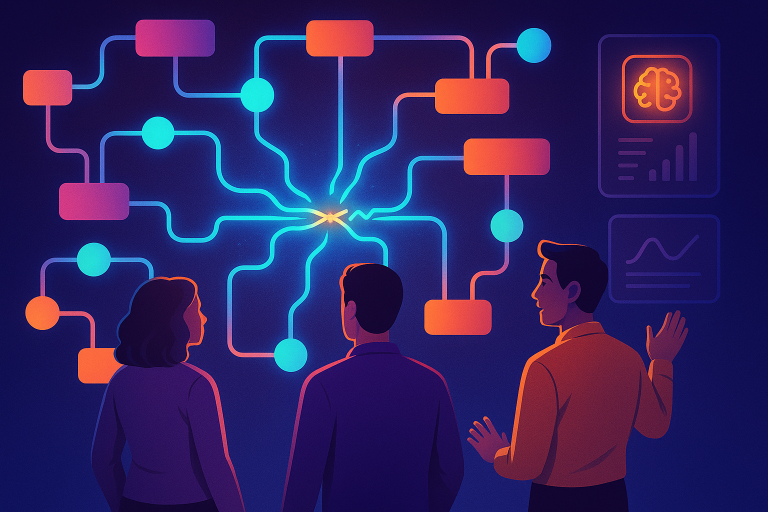Self-Healing Workflows: How Automations Can Detect and Fix Their Own Problems
In today’s fast-paced business environment, downtime is more than just an inconvenience—it’s a costly liability that can damage your reputation, reduce productivity, and impact your bottom line. What if your automated processes could detect when something’s wrong and fix themselves before you even notice the problem? That’s the promise of self-healing workflows, a revolutionary approach to automation that’s transforming how businesses maintain operational resilience.

What Are Self-Healing Workflows?
Self-healing workflows represent the next evolution in business process automation—systems intelligent enough to monitor their own health, identify issues, and implement fixes without human intervention. Think of them as the immune system for your business operations: constantly vigilant, immediately responsive, and increasingly sophisticated in how they maintain operational wellness.
Definition and Core Components
A self-healing workflow is an automated business process that incorporates monitoring, diagnostics, and recovery mechanisms to detect failures or performance issues and automatically implement corrective actions without human intervention.
The architecture of these systems typically includes:
- Monitoring layer: Continuously observes system performance, resource utilization, and process states
- Diagnostic engine: Analyzes anomalies and identifies root causes of issues
- Decision framework: Determines appropriate response actions based on predefined rules or ML algorithms
- Execution mechanism: Implements the selected recovery actions automatically
- Learning component: Improves responses based on historical outcomes and feedback
While traditional automation systems require human operators to respond to alerts and implement fixes, self-healing workflows complete the automation loop by bringing recovery and resilience into the automated domain. This approach builds upon the autonomic computing principles first introduced by IBM in the early 2000s, which established the vision of self-managing IT systems.
Evolution from Traditional Workflows
The journey toward self-healing capabilities has been a gradual evolution rather than a revolution. Traditional workflows have long incorporated basic error handling through:
- Try-catch blocks and exception handling
- Alert systems notifying human operators
- Manual restart procedures and documented recovery steps
However, these approaches all share a critical limitation: they depend on human intervention to complete the recovery process. As business process complexity has increased, the limitations of this human-dependent model have become increasingly apparent.
Today’s shift toward autonomous recovery is being driven by several factors:
- The growing complexity of interconnected systems
- Increasing cost of operational downtime
- Advancements in AI and machine learning capabilities
- Rising expectations for 24/7 availability
Industry adoption of self-healing automation is accelerating, with sectors like telecommunications, financial services, and cloud infrastructure leading the way due to their critical availability requirements and complex operational environments.
The Business Case for Self-Healing Workflows
The appeal of self-healing workflows extends beyond technical elegance—it’s about tangible business benefits that directly impact operational efficiency and the bottom line.
Reducing Operational Costs
Implementing self-healing capabilities delivers cost savings through multiple channels:
| Cost Reduction Area | Impact Mechanism | Typical Savings |
|---|---|---|
| Manual intervention | Reduction in human troubleshooting time | 40-70% decrease in support tickets |
| System downtime | Faster recovery from failures | 50-90% reduction in MTTR |
| Resource utilization | Dynamic reallocation during processing issues | 15-30% improvement in resource efficiency |
| Staffing requirements | Lower need for 24/7 operational monitoring | 20-40% reduction in overnight staffing |
Organizations that have implemented mature self-healing capabilities report that the ROI typically becomes positive within 6-12 months of deployment, with ongoing cost avoidance continuing to accumulate thereafter.
Improving Business Continuity
Beyond direct cost savings, self-healing workflows deliver significant business continuity benefits:
- True 24/7 operations: Systems can recover from issues outside business hours without waiting for staff availability
- Resilience during peak loads: Automatic resource provisioning and recovery during high-demand periods
- Enhanced disaster recovery: Faster, more consistent recovery processes that don’t depend on human memory or documentation
- Improved customer experience: Fewer service disruptions and faster recovery when issues do occur
These benefits are particularly valuable in customer-facing operations, where service disruptions have immediate reputational consequences. By minimizing the visibility of system failures to end users, self-healing workflows help maintain trust and satisfaction even when problems occur behind the scenes.
Technical Architecture of Self-Healing Systems
Creating truly self-healing workflows requires a thoughtfully designed technical architecture with specialized components for monitoring, decision-making, and recovery execution.
Monitoring and Detection Mechanisms
Effective self-healing begins with comprehensive, real-time monitoring:
- Performance metrics tracking: Response times, throughput rates, resource utilization, error rates
- Log analysis: Pattern recognition across application and system logs
- Synthetic transactions: Proactive testing of system functions and user journeys
- Dependency mapping: Monitoring interconnected services and their health status
Modern monitoring approaches increasingly incorporate anomaly detection algorithms that establish dynamic baselines of “normal” behavior rather than relying solely on static thresholds. This enables more nuanced detection of emerging issues before they cause outright failures.
The most sophisticated systems implement both reactive detection (responding to failures after they occur) and proactive detection (identifying patterns that predict likely failures before they happen).

Decision-Making Logic
Once an issue is detected, the system must determine the appropriate response through decision frameworks such as:
- Rule-based systems: Predefined if-then logic for known failure scenarios
- Machine learning models: Pattern recognition for novel or complex failures
- Policy enforcement: Applying corporate governance rules to recovery actions
- Impact-based prioritization: Focusing on issues with the highest business impact first
The decision component must balance several competing factors:
| Factor | Consideration |
|---|---|
| Speed vs. accuracy | How quickly to act versus gathering more diagnostic data |
| Recovery cost vs. downtime cost | Resource-intensive recovery options versus accepting longer outages |
| Automation confidence | When to proceed automatically versus escalating to human operators |
| Dependency awareness | Understanding the broader impact of local recovery actions |
Recovery Execution Systems
Automated recovery systems implement the chosen response through various mechanisms:
- Transaction rollbacks: Returning systems to a known-good state
- Checkpointing and restart: Resuming processes from the last valid checkpoint
- Resource reallocation: Provisioning additional capacity or shifting workloads
- Graceful degradation: Temporarily disabling non-critical features to maintain core functionality
- Configuration adjustments: Dynamically modifying system parameters to address performance issues
Most mature implementations combine these approaches in a tiered strategy, starting with lightweight, low-risk recovery methods before escalating to more disruptive interventions if initial attempts are unsuccessful.
Implementation Strategies
Adopting self-healing workflows doesn’t require an all-or-nothing approach. Organizations can implement these capabilities gradually, focusing on the highest-value opportunities first.
Phased Adoption Approach
A pragmatic implementation typically follows this progression:
- Assessment phase: Identify workflows with the highest downtime costs and most frequent failures
- Monitoring enhancement: Improve observability before adding recovery automation
- Controlled piloting: Implement self-healing for a small set of well-understood failure scenarios
- Gradual expansion: Add more recovery pathways as confidence grows
- Advanced analytics integration: Incorporate predictive capabilities and machine learning
Success metrics should be established early to measure progress:
- Reduction in mean time to repair (MTTR)
- Decrease in human escalations
- Improvement in system availability percentage
- Recovery success rate for automated healing attempts
Technology Stack Considerations
Your existing technology landscape will influence implementation options. Key considerations include:
- Workflow engine compatibility: Not all workflow platforms support the necessary hooks for self-healing
- Monitoring integration: Existing APM and monitoring tools may need enhancements
- API availability: Recovery actions typically require comprehensive API access to all system components
- Deployment environment: Cloud environments often provide more native self-healing capabilities than on-premises infrastructure
Many organizations find that a hybrid approach combining existing workflow platforms with specialized self-healing orchestration tools offers the fastest path to implementation while leveraging existing investments.
Common Use Cases and Examples
Self-healing workflows are being successfully applied across a wide range of business and technical domains.
IT Operations and DevOps
Some of the most mature implementations can be found in IT infrastructure and application delivery:
- Infrastructure provisioning recovery: Automatically detecting failed resource allocation and retrying with alternative configurations or providers
- Deployment pipeline resilience: Self-healing CI/CD pipelines that can recover from common build and deployment failures
- Automated scaling: Systems that not only scale based on demand but can detect and resolve scaling failures
- Configuration management: Detecting and correcting configuration drift or unauthorized changes
Example: A major cloud provider implemented self-healing deployment pipelines that reduced failed deployments by 78% and eliminated nearly all after-hours support calls for deployment issues.
Business Process Applications
Beyond pure IT operations, self-healing workflows are delivering value in core business processes:
- Financial processing: Transaction workflows that can automatically retry failed payments with alternative methods or routes
- Customer service systems: Support ticket routing that detects and corrects misrouting or backlogs
- Supply chain operations: Order processing systems that can recover from vendor API failures or data format issues
- Healthcare systems: Patient data workflows with automatic recovery for interrupted transfers or integration failures
Example: A healthcare provider implemented self-healing data integration across 17 systems, reducing manual data correction needs by 94% and improving both staff and patient satisfaction with information accuracy.
Future Trends in Self-Healing Automation
The field of self-healing workflows continues to evolve rapidly, with several emerging trends shaping its future development.
AI and Advanced Analytics Integration
The next generation of self-healing capabilities will be increasingly AI-driven:
- Predictive failure analysis: Using machine learning to identify patterns that precede failures
- Natural language interfaces: Allowing operators to interact with and guide self-healing systems through conversation
- Cognitive decision systems: Moving beyond rules to weigh complex factors in recovery decisions
- Self-optimization: Systems that don’t just recover but continuously improve their own performance
These advancements will increasingly blur the line between operational maintenance and continuous improvement, with systems that adapt and evolve based on operational experience.
Cross-System Healing Orchestration
As individual self-healing components mature, attention is shifting to enterprise-wide healing coordination:
- Service mesh resilience: Coordinated recovery across microservices architectures
- Multi-cloud healing strategies: Recovery that spans public and private cloud environments
- Business ecosystem resilience: Extending recovery coordination to partner and supplier systems
- Industry standards development: Emerging frameworks for interoperable self-healing across vendor boundaries
These broader orchestration capabilities will enable truly end-to-end resilience, rather than islands of automation that can recover individually but fail to coordinate.
Conclusion
Self-healing workflows represent a significant evolution in how businesses approach operational resilience. By closing the automation loop—extending from monitoring through diagnosis to automated recovery—organizations can achieve unprecedented levels of system availability while reducing operational costs.
While implementation requires careful planning and a phased approach, the benefits in terms of business continuity, customer experience, and operational efficiency make this a high-value investment for most organizations. As AI capabilities continue to advance, we can expect self-healing workflows to become increasingly sophisticated, moving from reactive recovery to predictive avoidance of issues before they occur.
The question for forward-thinking organizations is no longer whether to implement self-healing capabilities, but how quickly they can begin the journey toward more autonomous, resilient operations.




